There is a lot of scientific evidence that proves that balanced dog training works. Dogs that are trained using positive reinforcement techniques are more likely to be obedient and well-behaved than those that are not.
Balanced dog training is a system of training that uses positive reinforcement techniques to teach dogs to avoid unwanted behaviors and the behaviors we want them to exhibit.
It is important to note that balanced dog training is not a specific method or set of techniques, but rather a philosophy that we can be apply to any training system.
Balanced dog training is based on the principle that dogs are more likely to repeat behaviours that result in positive outcomes (reinforcement) and less likely to repeat behaviours that result in adverse effects (punishment).
What is a reinforcer in balanced dog training?
A reinforcer is anything that increases the frequency of a behavior. There are two types of reinforcers: positive and negative.
Positive reinforcement is when you add something to increase the frequency of a behavior. For example, if you give your dog a treat when they sit on cue, the behavior of sitting is more likely to occur in the future.
Negative reinforcement is when you remove something to increase the frequency of a behavior. For example, if you are asking your dog to sit and they are pulling on the leash, you may give them a slight tug to get their attention. Once they sit, you release the pressure on the leash. The behavior of sitting is more likely to occur in the future because of the absent of pressure on the leash.
What is a punisher in balanced dog training?
A punisher is anything that decreases the frequency of a behavior. There are two types of punishers: positive and negative. Read here for more in-depth information.
The concept of positive punishment is when you add something to decrease the frequency of a behavior. For example, the behavior of jumping is less likely to occur in the future if you spray your dog with water when they jump on you.
Negative punishment is when you remove something to decrease the frequency of a behavior. For example, the behavior of jumping is less likely to occur in the future when your dog jumps on you and you turn your back and walk away because the attention of the handler is being removed
The key to successful balanced dog training is to find the right balance of reinforcement and punishment for your individual dog. Every dog is different and will respond differently to different training methods. It is important to experiment with different techniques and find what works best for you and your dog.
By providing this balance, the dog is able to learn what they should be doing and what they should avoid. A dog trained solely with corrections is more likely to allow their handler to administer corrections instead of responding to verbal cues. A dog trained only with rewards may become a “velcro” dog who is only motivated by food but not responsive to other cues. A well-balanced dog is one that responds to verbal cues and is motivated by more than just food rewards.

How to achieve balanced dog training?
A training goal is a concrete, measurable, and attainable behavior that you want your dog to learn. It is usually involves a cue that is paired with a desired behavior. For example, you may want your dog to respond to the cue “sit” in a variety of environments and situations. Once you have decided on a training goal, you can begin to break it down into smaller, more manageable steps.
How do you break a training goal down into smaller steps?
You break a training goal down into smaller steps by using a behavior chain. A behavior chain is a series of behaviors that link together to achieve a desired outcome. For example, if you want your dog to learn to sit on cue, the behavior chain may look like this: 1. Dog is standing 2. Handler says “sit” 3. Dog sits.
In order to teach your dog the behavior chain, you will need to break it down into even smaller steps. For example, you may start by teaching your dog to sit when you say “sit” while you are standing next to them. Once your dog is consistently responding to the cue in that environment, you can begin to add distractions or move to different locations. As your dog masters the behavior in different environments, you can begin to put the behaviors together to form the behavior chain.
Some of the most common management tools used in balanced dog training include:
- Teaching your dog basic obedience commands
- Using a leash and prong collar to control your dog’s movement
- Using a crate or dog-proof area to confine your dog when necessary
- Use food, toys, and other forms of positive reinforcement to rewards your dog for desired behaviors
Conclusion
One way to find out what works best for your dog is to seek professional help. Many professional dog trainers offer a variety of services, including behavioral consultations, private lessons, and group classes.
If you decide to train your dog yourself, there are a few things to keep in mind.
First, be consistent with your commands and rewards. Dogs learn best when pet owners give them clear and consistent instructions.
Second, use positive reinforcement whenever possible. Positive reinforcement, such as treats or praise, will help your dog associate good behavior with something pleasant.
Finally, be patient. Dogs learn at their own pace, so it is important to be patient and not get frustrated if your dog does not seem to be progressing as quickly as you would like.
For more articles, please visit here.
